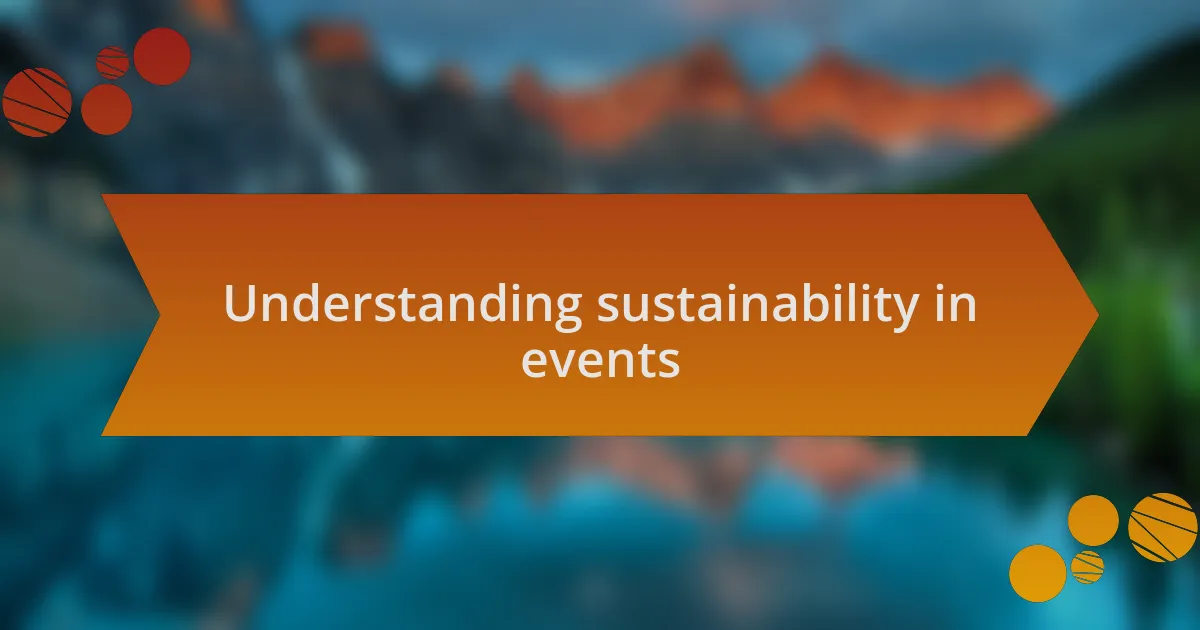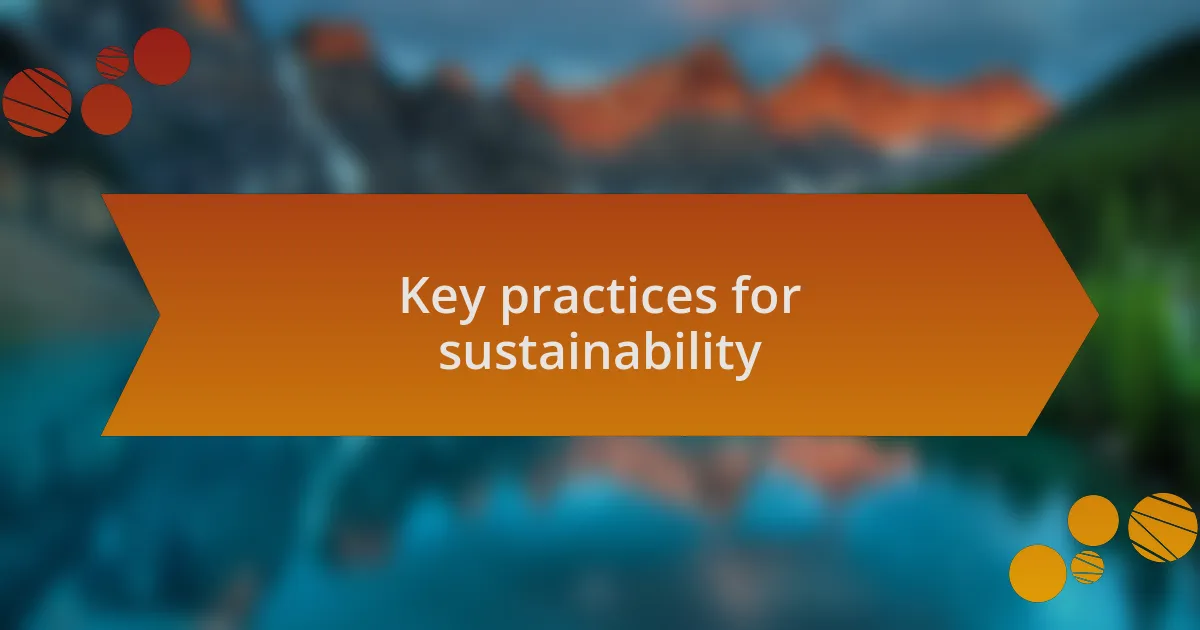Key takeaways:
- Sustainability in events encompasses a holistic approach that respects both the environment and community, moving beyond simple practices like recycling.
- Key practices for sustainable events include reducing waste at the source, choosing local vendors, and fostering a culture of sustainability among participants.
- Challenges such as stakeholder resistance and sourcing eco-friendly materials highlight the importance of changing mindsets towards viewing sustainability as an investment.
- Successful initiatives, like adopting zero-waste models and collaborating with local farmers, enrich event experiences and promote community engagement in sustainability efforts.

Understanding sustainability in events
Sustainability in events goes beyond just recycling cups or using energy-efficient lighting; it’s about creating a holistic experience that respects the environment and community. I remember attending an art exhibition where every detail, from the locally sourced materials for installations to the zero-waste catering, resonated with me. It made me ponder—how much more impactful are events that honor sustainable practices?
When I first started exploring sustainable event practices, I was surprised to learn about the carbon footprint of an art showing. Did you know that transportation, food waste, and even decor can contribute significantly? Understanding these factors helped me appreciate the value of local partnerships in reducing that impact, and it transformed how I view event planning.
Imagine walking into a gallery where every aspect is intentionally crafted to honor the earth and its resources. That was the feeling I had at a recent event focused on sustainable art. The art was not just a visual feast; it carried stories of the artists’ commitment to the environment. This experience made me realize that sustainability is not merely a trend; it’s an essential narrative in the evolution of how we engage with art and each other.

Key practices for sustainability
Sustainability in event management starts with reducing waste at the source. I once operated an art event where we chose digital invitations instead of paper. This small shift not only cut our resource consumption but also sparked conversations among attendees about their own waste habits. It was eye-opening to see how one decision could ripple through the event and inspire a collective consciousness.
Another key practice involves selecting vendors who prioritize sustainable options. For an exhibition I helped coordinate, we partnered exclusively with caterers who utilized seasonal, organic ingredients. Not only did this choice enhance the quality of the food, but witnessing the guests savoring each bite was rewarding. It reinforced my belief that sustainability and satisfaction can go hand in hand.
Incorporating sustainability isn’t just about making choices; it’s about creating a culture around them. I remember an event where we had an interactive session discussing artistic approaches to environmental themes. Participants left feeling empowered, as if they were part of something larger than themselves. This engagement fosters a deeper appreciation for sustainability—and it reminds me that every event has the potential to inspire meaningful change.

My personal experiences in sustainability
Reflecting on my journey, I recall a particular moment during an outdoor exhibition where we made a point to use biodegradable materials for all our displays. Watching the wind ripple through these eco-friendly installations felt magical, yet it also brought a pang of responsibility. I couldn’t help but wonder—how many more events could adopt this approach and leave a positive mark on our planet?
One experience that stood out to me was when we organized a community cleanup alongside an art showcase. As artists painted vibrant murals, I saw volunteers picking up trash, their commitment transforming our space. The juxtaposition of art and ecological responsibility was profound, stirring emotions I didn’t anticipate. It made me realize that sustainability isn’t just a practice; it’s inherently tied to our collective creativity and desire for beauty.
On another occasion, I facilitated a panel discussion on the intersection of art and sustainability. I was struck by the diverse perspectives shared by artists, each resonating with their own environmentally conscious journeys. It left me pondering how our individual narratives could unite to shape a more sustainable future. It turns out, every story matters, and when combined, they have the power to spark real change.

Challenges faced in sustainability efforts
One significant challenge in sustainability efforts is the resistance from various stakeholders. I remember a lively debate during a planning meeting where some team members were hesitant to invest in sustainable materials, worried about the upfront costs. This situation led me to ponder: how can we shift mindsets to see sustainability not just as an expense, but as an investment in a better future?
Another hurdle I faced was sourcing eco-friendly supplies that met both artistic standards and environmental criteria. There was a moment when I eagerly opened a shipment of recycled paint, only to find it didn’t meet our color expectations. Frustration washed over me as I thought, how can we balance creativity with sustainability without compromising on quality?
Lastly, the issue of educating attendees about sustainability practices often feels like an uphill battle. I vividly recall chatting with visitors at an art event, trying to explain the importance of reducing waste and composting. Some were engaged, while others seemed indifferent. It sparked a question in my mind: how do we inspire a genuine commitment to sustainability in a world full of distractions?

Successful sustainability initiatives at events
Successful sustainability initiatives at events can significantly enrich the experience for both organizers and attendees. I once witnessed a local art festival’s decision to switch to a zero-waste model. As trash cans around the venue were replaced with compost and recycling stations, I felt a surge of pride. It was incredible to see attendees actively participating in sorting their waste, truly embodying the spirit of sustainability. How satisfying is it to see everyone join a collective effort, turning simple actions into meaningful change?
In another experience, an art show embraced digital ticketing and virtual tours, cutting down on paper waste and minimizing carbon emissions from travel. The energy was electric as attendees could engage with the artworks from anywhere in the world. This shift not only showcased innovation but also opened up access to a broader audience. It made me ponder: can technology be our best ally in promoting sustainability while enhancing creativity and participation?
One of my favorite instances of sustainability at events came when a gallery partnered with local farmers to provide organic catering. The connection between art and local produce created a beautiful buffet that was as vibrant as the artwork displayed. I still recall the conversations sparked around those tables, where attendees shared their thoughts on sustainability in art and food. How powerful is it for participants to engage in dialogue about their contributions to sustainability while savoring something delicious? This synergy between food, art, and community truly highlighted the importance of collaboration for successful sustainability initiatives.